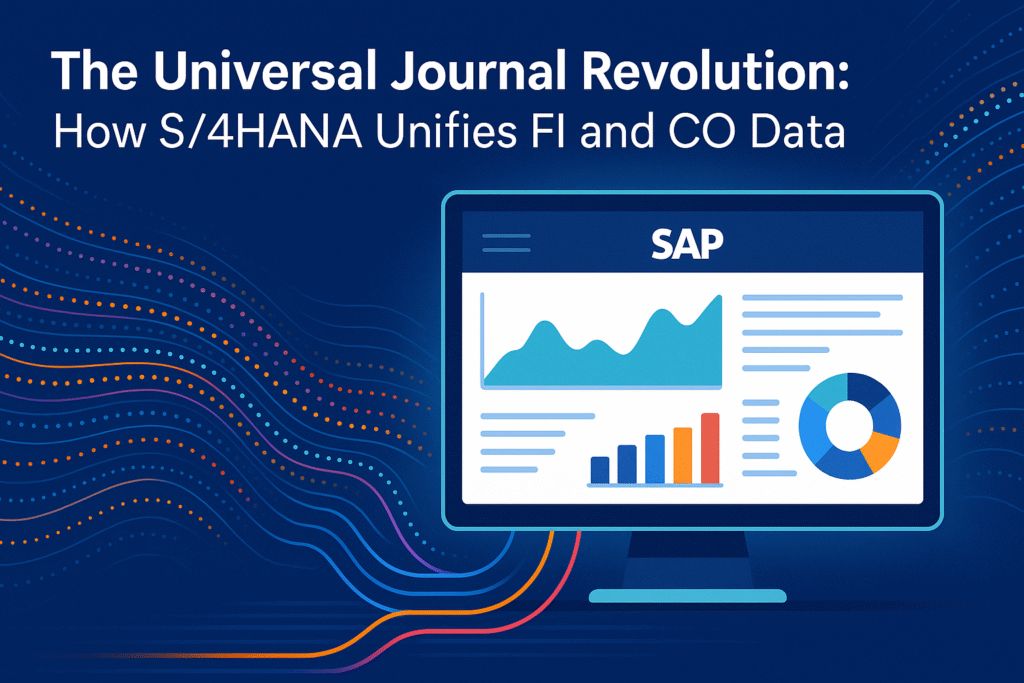The Universal Journal represents the most fundamental architectural transformation in SAP’s enterprise finance solutions since the inception of R/3. By consolidating Financial Accounting (FI) and Controlling (CO) data into a single, unified table structure, SAP S/4HANA eliminates decades-old data silos and creates what industry analysts call the “single source of truth” for financial operations. This revolutionary approach transforms how organizations capture, process, and analyze financial data, delivering real-time insights that were previously impossible in traditional ERP architectures.
The Architectural Foundation: From Multiple Tables to ACDOCA
The Traditional ECC Challenge
In SAP ECC, financial data fragmentation created significant operational complexity. Financial Accounting transactions were stored in tables like BSEG, while Controlling data resided in COEP, asset accounting in ANEP, and material ledger information in MLIT. This distributed architecture required constant reconciliation between modules, often taking finance teams days to align FI and CO balances during month-end closing.
Key ECC Limitations:
Separate storage for FI and CO transactions across multiple tables
Time-consuming reconciliation processes between modules
Delayed reporting due to batch processing requirements
Data redundancy across aggregate and index tables
Limited real-time visibility into integrated financial performance
The Universal Journal Transformation
The Universal Journal, technically implemented as table ACDOCA, fundamentally reimagines financial data architecture. This single table stores all transactional data from General Ledger, Controlling, Asset Accounting, Material Ledger, and Profitability Analysis in one unified structure. With over 500 fields accommodating diverse business requirements, ACDOCA serves as the comprehensive repository for all financial transactions.
Revolutionary Architecture Features:
Single table design eliminating data fragmentation
Sparsely filled matrix optimizing storage efficiency
On-the-fly calculations replacing pre-calculated aggregates
Columnar data processing leveraging SAP HANA capabilities
Real-time data availability across all finance modules
Unifying Financial and Management Accounting
Breaking Down Traditional Silos
The Universal Journal eliminates the historical separation between external (FI) and internal (CO) accounting by creating integrated chart of accounts where G/L accounts and cost elements become unified master data objects. When organizations create primary or secondary cost G/L accounts in S/4HANA, the system automatically generates corresponding cost elements, ensuring seamless integration between financial and management accounting.
Integration Components:
General Ledger Accounting (FI-GL) with complete transaction history
Controlling (CO) including cost centers, profit centers, and internal orders
Asset Accounting (FI-AA) with depreciation and asset movements
Material Ledger (ML) for inventory valuation and actual costing
Profitability Analysis (CO-PA) with margin analysis capabilities
Permanently Reconciled Financials
The most significant advantage of Universal Journal implementation is the elimination of FI-CO reconciliation requirements. Since all financial transactions write to ACDOCA simultaneously, legal and management accounting data remain permanently aligned without manual intervention. This architectural change transforms month-end closing from a multi-day reconciliation exercise into streamlined, automated processes.
Reconciliation Benefits:
Zero reconciliation effort between FI and CO modules
Instant data consistency across all financial reporting
Automated period-end processing with built-in validation
Real-time financial consolidation capabilities
Enhanced audit trails with complete transaction lineage
Performance and Technical Advantages
In-Memory Processing Revolution
SAP HANA’s in-memory architecture enables the Universal Journal to perform calculations directly at the database layer, eliminating traditional batch processing limitations. Unlike ECC’s reliance on aggregate tables and overnight processing, S/4HANA delivers instant query responses and real-time analytical processing.
Technical Performance Improvements:
Sub-second query response times for complex financial analyses
Real-time calculations replacing pre-calculated totals
Columnar data compression reducing storage requirements by 80-90%
Parallel processing capabilities across multiple dimensions
Elimination of 26+ traditional tables through MATDOC integration
Simplified Data Model Benefits
The Universal Journal’s streamlined architecture delivers measurable performance improvements across financial operations. Organizations report 70% reduction in data processing time and 50% improvement in reporting accuracy after implementing S/4HANA with Universal Journal.
Operational Improvements:
Single table maintenance instead of multiple synchronized tables
Reduced memory footprint through elimination of redundant data
Enhanced system throughput with optimized data structures
Simplified backup and recovery procedures
Lower total cost of ownership through infrastructure optimization
Real-Time Reporting and Analytics Revolution
Instant Financial Visibility
The Universal Journal enables continuous financial reporting rather than periodic batch-driven processes. CFOs and finance teams can access current financial positions, drill down to transaction details, and perform complex analyses without waiting for overnight processing cycles.
Real-Time Capabilities:
Live profit and loss statements with drill-down to source transactions
Instantaneous balance sheet preparation across multiple dimensions
Real-time cash flow analysis integrating all financial modules
Dynamic variance analysis comparing actual to planned performance
Immediate regulatory reporting with built-in compliance monitoring
Enhanced Decision-Making Support
Organizations implementing Universal Journal report 60% faster decision-making cycles and 40% improvement in forecast accuracy. The integrated data structure enables CFOs to respond immediately to board inquiries with real-time financial analysis and scenario modeling.
Decision Support Enhancements:
Predictive analytics integrated into operational processes
What-if scenario modeling with instant results
Cross-company consolidation in real-time
Multi-dimensional profitability analysis without separate extraction
Embedded intelligence for automated exception detection
Implementation Considerations and Challenges
Migration Complexity
Transitioning from ECC’s multiple-table architecture to Universal Journal requires comprehensive data transformation and process reengineering. Organizations must address custom code modifications, interface adaptations, and user training to fully realize Universal Journal benefits.
Key Implementation Challenges:
Custom code adaptation for ACDOCA table structure
Historical data migration from multiple source tables
Interface modifications for third-party system connections
User training requirements for new data access patterns
Performance optimization for large data volumes
Change Management Requirements
The Universal Journal fundamentally changes how finance professionals interact with SAP systems, requiring comprehensive organizational change management. Management accountants and financial analysts must adapt to new reporting paradigms and real-time data availability.
Organizational Adaptations:
Role redefinition reflecting real-time analytical capabilities
Process standardization leveraging embedded automation
Skill development for advanced analytics and scenario modeling
Governance framework updates for enhanced data quality
Performance measurement aligned with real-time insights
Business Value Realization
Quantified Performance Improvements
Organizations implementing Universal Journal achieve measurable business benefits across multiple dimensions. Finance function costs reduce by 30% while processing accuracy improves by 90% through automated reconciliation and real-time validation.
Measured Business Impact:
45-second invoice processing versus 12-minute manual processing
50% reduction in days sales outstanding (DSO) through real-time cash application
70% improvement in financial planning accuracy with integrated analytics
30% decrease in total finance operations costs through automation
60% faster month-end closing cycles with elimination of reconciliation
Strategic Competitive Advantages
Universal Journal implementation enables finance organizations to transition from transactional processing to strategic advisory roles. CFOs report enhanced ability to provide real-time business insights and support strategic decision-making with immediate analytical responses.
Strategic Benefits:
Real-time profitability analysis across products, customers, and regions
Dynamic cash flow forecasting with scenario planning capabilities
Integrated risk management with automated monitoring and alerts
Enhanced compliance reporting with built-in regulatory frameworks
Accelerated business process innovation through flexible data structures
Future-Ready Finance Architecture
Artificial Intelligence Integration
The Universal Journal’s unified data structure provides the foundation for advanced AI and machine learning applications in finance. Organizations can implement predictive analytics, automated anomaly detection, and intelligent process automation directly on transactional data without complex extraction procedures.
AI-Enabled Capabilities:
Predictive cash flow modeling using machine learning algorithms
Automated variance investigation with intelligent root cause analysis
Dynamic customer credit scoring based on real-time payment patterns
Intelligent journal entry validation preventing errors before posting
Automated regulatory compliance monitoring with exception alerts
Cloud-Native Financial Operations
Universal Journal architecture aligns perfectly with cloud-native deployment models, enabling organizations to leverage elastic computing resources and advanced analytics services. The simplified data structure reduces cloud infrastructure requirements while enhancing scalability.
Cloud Optimization Benefits:
Reduced cloud storage costs through data model simplification
Enhanced scalability with elastic computing capabilities
Integrated analytics services without separate data warehousing
Automated backup and disaster recovery with simplified structures
Global deployment flexibility with standardized data models
Industry Transformation Impact
Redefining Finance Excellence
The Universal Journal represents a paradigm shift from periodic financial reporting to continuous financial intelligence. Organizations can now operate with financial transparency that was previously impossible, enabling agile response to market changes and strategic opportunities.
Transformation Outcomes:
Finance teams become strategic business partners rather than transaction processors
Real-time compliance monitoring replaces periodic audit preparations
Continuous planning cycles replace annual budgeting processes
Integrated performance management spans financial and operational metrics
Predictive insights drive proactive business management
Setting New Industry Standards
Organizations implementing Universal Journal capabilities establish competitive advantages through superior financial agility and insight. The ability to provide immediate, accurate financial analysis positions these companies as industry leaders in financial excellence.
The Universal Journal revolution in SAP S/4HANA fundamentally transforms enterprise financial management from a retrospective, reconciliation-intensive process to a prospective, insight-driven strategic capability. By unifying FI and CO data in a single, real-time accessible structure, organizations unlock unprecedented financial transparency, operational efficiency, and strategic agility that defines the future of enterprise finance.



